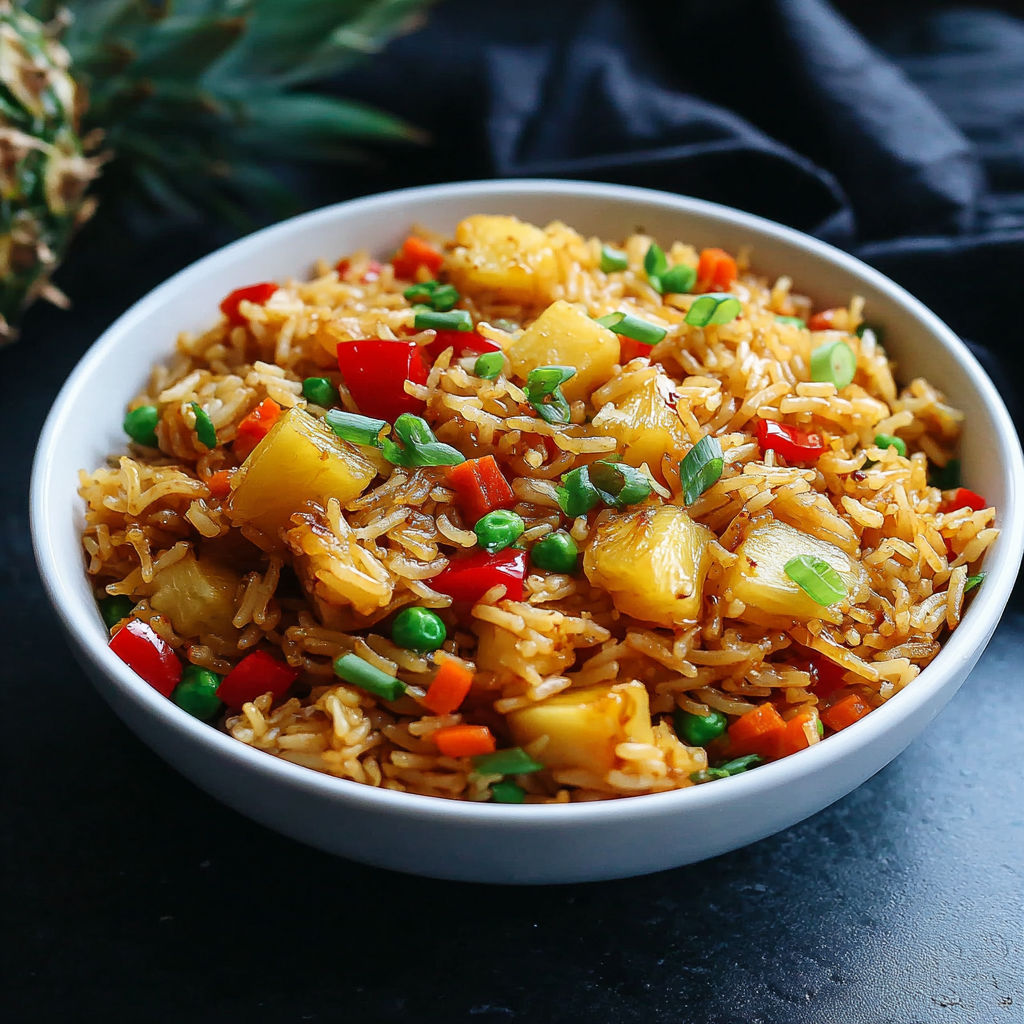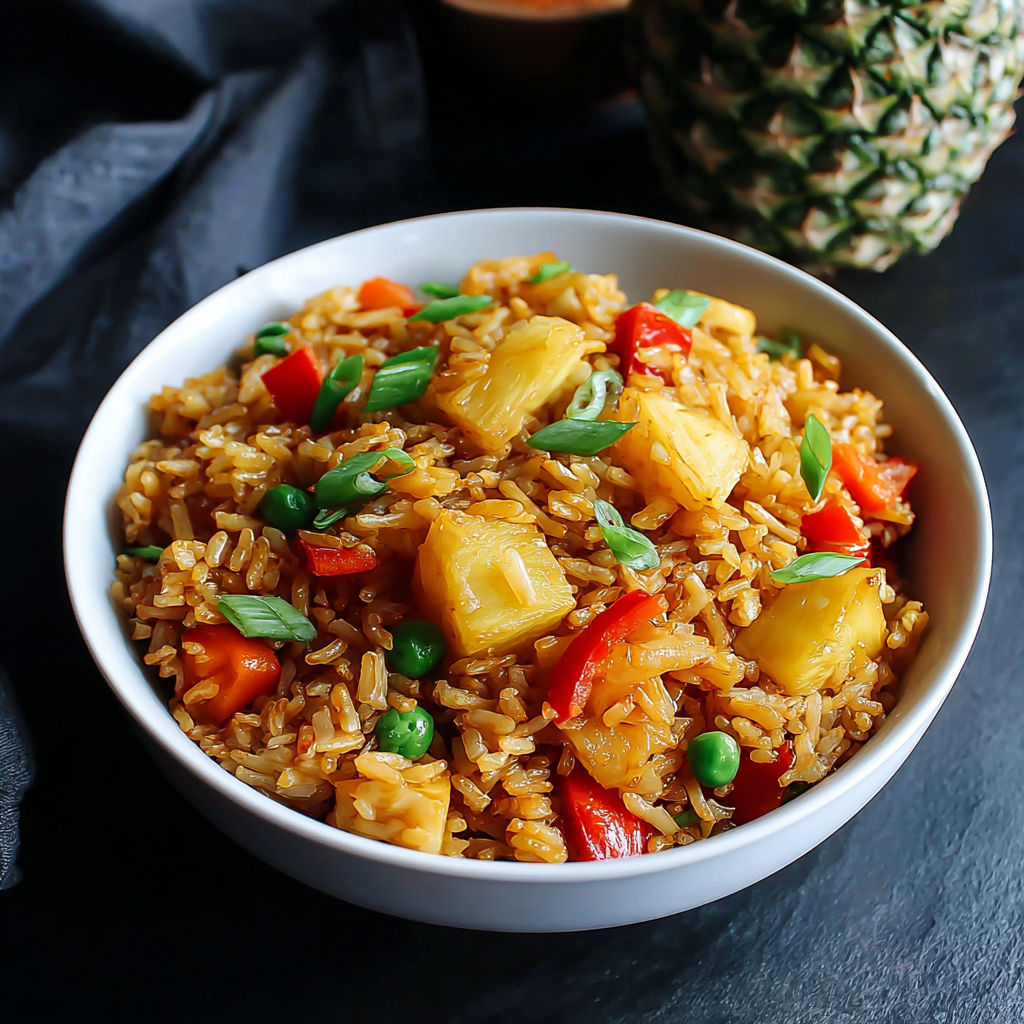 Highlight
Highlight
This Vegetarian Pineapple Fried Rice brings together the sweetness of pineapple with fresh vegetables and fluffy rice for a satisfying meal that works perfectly for weeknight dinners. It is light but packed with flavor and can be easily customized to suit your pantry or whatever produce you have on hand.
I first made this on a quiet weeknight and was surprised how effortlessly the pineapple lifts the whole dish. It quickly became one of my go-to meals when I wanted something healthy but still exciting.
Gather Your Ingredients
- Two cups of rice: Use day-old rice for the best texture as fresh rice can turn mushy
- One cup of fresh pineapple: Adds natural sweetness, if using canned, drain well to avoid sogginess
- One cup of diced bell pepper: Brings vibrant color and a pleasant crunch
- One medium carrot: Thinly sliced for quicker and even cooking
- One cup of peas: Frozen peas are convenient and add a pop of green
- One cup of tofu: Optional for protein, press it lightly to avoid excess moisture
- Two tablespoons of soy sauce or tamari: Tamari works if you need gluten-free and adds depth of flavor
- One tablespoon of sesame oil: Adds a rich, nutty aroma that defines the dish
- One tablespoon of maple syrup or agave or brown sugar: Optional to boost sweetness depending on your pineapple’s ripeness
How to Make It
- Sauté the Vegetables:
- Heat one to two tablespoons of sesame oil over medium heat in a large skillet. Add the diced bell pepper, thinly sliced carrot, and peas. Stir-fry for five to seven minutes until vegetables soften but still keep a bit of crunch.
- Mix in Pineapple and Sauce:
- Add the chopped pineapple pieces into the skillet along with the soy sauce or tamari. Stir together carefully and cook for another three to four minutes so the pineapple warms through and the sauce evenly coats the ingredients.
- Incorporate the Rice:
- Gently add the cooled day-old rice to the skillet. Stir-fry for five to six minutes, breaking up any clumps and mixing everything so each grain gets coated with the flavors.
- Garnish and Serve:
- Transfer the finished fried rice to a serving dish and garnish with any optional toppings you like such as chopped green onions, sesame seeds, or fresh cilantro. Serve immediately while warm.

My favorite ingredient has to be the pineapple because it adds a juicy sweetness that contrasts beautifully with the savory soy sauce. I remember making this the first time for a family dinner, and everyone was surprised how the pineapple made it feel like a special occasion even on a weeknight.
Flavor Boosters
Serve with a side of steamed greens or a simple cucumber salad to add freshness. Garnish with chopped nuts like cashews or peanuts if you desire a crunchy contrast.
Serving Suggestions
Pineapple fried rice has its roots in Southeast Asian cuisine, especially Thai, where the combination of sweet pineapple with savory rice is a popular street food. The vegetarian twist makes it accessible for all diet types without losing any of its charm.
Creative Twists
Adjust the vegetables based on what’s fresh and local. Swap peas for green beans or snap peas in spring. Add corn or chopped zucchini in summer for variety. Use root vegetables like parsnips or rutabaga in cooler months.

This recipe balances ease with bold flavors, delivering a delicious meal every time you make it.
Common Questions About the Recipe
- → Can I use freshly cooked rice for this dish?
Freshly cooked rice can be used, but day-old refrigerated rice yields a better texture and prevents clumping during stir-frying.
- → What type of pineapple works best?
Fresh pineapple is preferred for its natural sweetness and juiciness, but canned pineapple works if well-drained.
- → Is tofu necessary in this dish?
Tofu is optional but adds plant-based protein and enhances the dish's heartiness.
- → How can I make this dish gluten-free?
Use tamari instead of soy sauce to keep the dish gluten-free without sacrificing flavor.
- → Can I add other vegetables?
Yes, feel free to customize with seasonal or leftover vegetables to suit your taste and availability.
- → What oil is best for stir-frying here?
Sesame oil is ideal for its nutty aroma, but vegetable or canola oil can be used if preferred.
